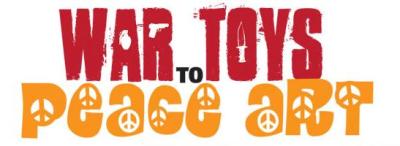|
|
From War Toys to Peace Art
un articulo por Larry Kuehn
British Columbia Teachers' Federation
[note: the following article is abbreviated from the BCTF Teacher Newsmagazine]
The media star of the show in the buildup to the World Peace Forum in Vancouver was the project called "From War Toys to Peace Art." In the weeks leading up to the end of June 2006, kids turning in their war toys captured symbolically the whole idea of the transformation that is necessary for peace.
The energy behind the project came from two people—Sam Fillipoff, a retired teacher, and Susan Ruzic, an elementary teacher in the suburban Coquitlam school district. Both were active in the organizing of the International Peace Education Conference that was the education component of the overall World Peace Forum...
About 500 teachers took part in the education conference. The same number of students took part on the day that had a focus on youth activities, including talks by Debra Ellis (see an interview in the Nov./Dec. 2006 issue of Teacher) and Silken Laumann speaking for Right to Play, an international NGO of athletes that focuses on play to enhance child development in areas of disadvantage globally.
While all these activities and talk would have an impact on participants, it was the war toys project that leaves a lasting physical legacy—artwork created from the war toys, a plastic version of "they shall beat their swords into ploughshares."

Logo from the website of wartoystopeaceart.com
This wasn’t the first example of symbolizing peace by transformation. In Mozambique, for example, several years ago CUSO ran a program of trading arms for other goods, an AK–47 for a sewing machine or a plow. This was part of the process of demilitarizing society after a long and vicious civil war. The weapons were transformed into sculptures which served as an ongoing reminder of the importance of finding non-violent ways of sorting out social and political differences.
In Cambodia, an art student took an AK–47 and created a beautiful bird sculpture. In Oakland, California, an elementary school exchanged toy weapons, violent DVDs, and video games for books and pencils.
The BC version of the project put together a number of these elements, along with some original touches. Susan Ruzic got one of the toy stores in her community to be a collection point—and to give the students a voucher that could be used as a discount toward a non-violent toy. Ruzic and Fillipoff worked with the UBC Museum of Anthropology to display the artwork created by Bill Thomson for six months. The museum even arranged workshops for students who would bring toys and take part in creating their own artwork...
They have also created an 80-page lesson aid package for teachers interested in carrying out their own "Acts of Transformation from War Toys to Peace Art." It contains lesson plans, background resources, and links to other sources of related information. A copy of the full package is being sent to all schools and it is available from the BCTF Lesson Aids Service through the web site www.bctf.ca.
|








|
DISCUSSION
Pregunta(s) relacionada(s) al artículo :
What is the best way to teach peace to children?,
* * * * *
Comentario más reciente:
Maria Montessori believed that peace was innate within children. Her timeless educational philosophy was developed around this basic understanding. Perhaps all we need to do as teachers is to provide stimulating learning environments that validate this knowing and understanding and nurture it. We may not have to actually teach it, Sharing peace-building stories gently attends to this. Strong, creative and imaginative peace-building characters who focus upon win-win and have faith in peace being possible are at the centre of the story plots. In Hassaun Ali-Jones Bey's (Boundless Gratitude http://boundlessgratitude.com/products.html ) unique and mesmerising story, Black Ink is such a character who bravely crosses the universe seeking validation of what he knows in his heart. The magical character also models all the important peace-building values, understandings and actions needed for peace-building. I believe also that peace-building must be modelled and the whole teaching-learning environment should reflect similar values, understandings and actions...as is the primary focus of the Save the Children Australia UN Global Peace School Program upon which I am presently fortunate to be working. . ... continuación.

|
|









